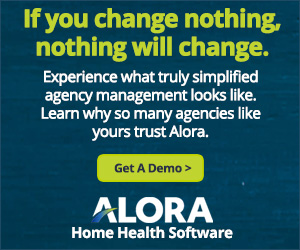
11 Nov Home Health Agency Challenges for Executives
What’s Impacting Home Health Agencies in 2023?
What’s on the horizon in home health agency management? As a home health owner or executive, having a solid plan to tackle the greatest obstacles your agency may face in 2023 will be the key to success.
Being a home health business owner can be rewarding, but it also poses challenges. Home health leaders and executives must balance the needs of patients and staff with the demands of running a business. That’s easier said than done–especially in a highly regulated industry full of compliance rules that frequently change. As we approach the end of another year, it’s time to consider what lies ahead. This article considers three challenges that home health executives and leaders will face in 2023 and how some in the industry plan to overcome them.
- Changes to the CMS Home Health Rule
- Staffing Concerns
- Managing the Cost of Care
Obstacle #1: Changes to the CMS Home Health Rule
As the final rule is written, CMS plans to reduce net home health payments by $810 million in the calendar year 2023 relative to CY 2022. If CMS does not pull back the payment reduction, Congress may provide some relief for home health agencies with the Preserving Access to Home Health Act. The bill would prevent CMS from implementing payment adjustments before 2026. Without a reprieve, CMS’s proposed rule could weaken the home health industry. Payment cuts in 2023 may be a real obstacle for agencies battling rising operational costs.
Dan Savitt, President and CEO of VNS Health (formerly Visiting Nurse Service of New York), said that his organization used its data to quantify the impact these cuts would have. Looking forward, he plans to work with CMS and industry colleagues to reverse this rule.
Other changes to the CMS home health final rule that will affect home health agency payments next year include:
- A permanent, budget-neutral 5.0 percent cap on negative wage index changes
- Recalibration of PDGM case-mix weights and LUPA thresholds
- Changes to the Home Health Value-Based Purchasing Program (new definitions for the baseline years)
To read the final rule, click here. The rule will be effective Jan. 1, 2023.
Obstacle #2: Staffing Concerns
Staffing is one of the greatest obstacles for home health businesses. The primary challenge is finding the right qualified employees and keeping them on the job. John Sammons, a non-skilled home care agency owner, explained, “caregivers are hard to find and stay on the job less than 90 days; we interview daily to get employees.”
Home healthcare companies have gotten creative to combat the high turnover rate. Many are offering continued skill development and clinical ladder advancement opportunities. Program specialization can also help keep your staff engaged and motivated as they pursue personal career goals while providing better care to your clients.
Many retention initiatives emphasize benefits like flexibility, opportunities for advancement and salary, and bonus structures that allow businesses to offer competitive wages without sacrificing profit margins. Strong onboarding programs for new hires have also been successful. Pete Morrissey, Owner of Right at Home, said agencies must think not only about the utility of the training but consider the ease of use and overall experience of training to see maximum retention benefits.
Obstacle #3: Managing the Cost of Care
As operational expenses rise due to inflation and reimbursement rates decrease, it’s more important than ever to manage costs. Today’s home health agencies are focused on more than just cutting. Many leaders are trying to find financial predictability in an unpredictable industry.
But although healthcare providers are under immense pressure to reduce costs, the evidence suggests that these attempts may be counterproductive — effectively raising costs and decreasing the quality of care.
Innovative home care exec Stacie Bratcher, CEO of Jet Health, said that her organization uses technology, such as remote patient monitoring and telehealth triage, to help manage care costs. “We believe this approach will lead to reduced hospitalizations, better-informed patients, enhanced communication, and improved overall outcomes,” she said.
It is a good time to consider what technologies and digital tools could help you improve operations and manage the cost of care, as well as the best ways to grow your home health agency. For example, maybe it’s time to consider an EMR software upgrade. Book a quick demo tailored to your agency’s needs if you want to see how Alora Home Health Software could make your work life easier.
The Takeaway
Home healthcare agency owners and leaders will face challenges ahead. However, the three greatest obstacles for home health on the horizon, including policy updates, staffing issues, and cost concerns, are manageable. Take time today to consider how you can face these challenges head-on.
If there is anything this industry knows, it’s how to be flexible and adapt to meet changing circumstances while staying true to the mission. We are confident that you will rise to the occasion.
Want to read more?
Check out our blog on “Four things successful homecare CEOs do daily“

Alora provides agencies with the complete solution for home health agency workflow. With regulatory concerns such as EVV, OASIS-E, and other challenges that are going into effect which directly impact agency workflow and requirements, having the right software in place is essential to preparedness and success.




No Comments